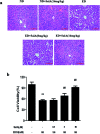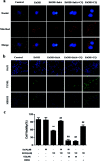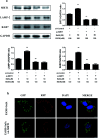Promotion of autophagosome-lysosome fusion via salvianolic acid A-mediated SIRT1 up-regulation ameliorates alcoholic liver disease
- PMID: 35541657
- PMCID: PMC9080827
- DOI: 10.1039/c8ra00798e
Promotion of autophagosome-lysosome fusion via salvianolic acid A-mediated SIRT1 up-regulation ameliorates alcoholic liver disease
Abstract
Salvianolic acid A (SalA) is a water-soluble phenolic carboxylic acid extracted from Salvia miltiorrhiza that has extensive pharmacological activities and plays an essential role in liver disease treatment. However, the mechanism of SalA in treating alcoholic liver disease (ALD) remains unclear. Here, we studied the protective effects of SalA on chronic ethanol-induced liver injury involving Sirtuin 1 (SIRT1)-mediated autophagy activation. The results showed that SalA pretreatment reduced the levels of alanine aminotransferase (ALT), aspartate aminotransferase (AST), triglyceride (TG) and cholesterol (TC) in vivo and enhanced hepatic cell viability while mitigating apoptosis and hepatic steatosis in vitro. Furthermore, SalA protected against chronic ethanol-induced liver injury by restoring autophagosome-lysosome fusion, as indicated by the increased expression levels of LC3-II, cathepsin B, lysosomal-associated membrane protein 2 (LAMP-2), and RAB7 and the decreased expression of SQSTM1. More importantly, pretreatment with SalA significantly up-regulated the expression of SIRT1, an NAD+-dependent deacetylase. These increased levels of SIRT1 stimulated autophagy under conditions of chronic ethanol exposure. Interestingly, SIRT1 siRNA abrogated SalA-induced autophagosome-lysosome fusion. This finding indicates that the protective effects of SalA are associated with SIRT1 activation. Collectively, our study demonstrates that SalA pretreatment protects against chronic ethanol-induced liver injury via the SIRT1-mediated restoration of autophagosome-lysosome fusion.
This journal is © The Royal Society of Chemistry.
Conflict of interest statement
There are no conflicts to declare.
Figures





Similar articles
-
Salvianolic acid A preconditioning confers protection against concanavalin A-induced liver injury through SIRT1-mediated repression of p66shc in mice.Toxicol Appl Pharmacol. 2013 Nov 15;273(1):68-76. doi: 10.1016/j.taap.2013.08.021. Epub 2013 Aug 28. Toxicol Appl Pharmacol. 2013. PMID: 23993977
-
Salvianolic acid A alleviates chronic ethanol-induced liver injury via promotion of β-catenin nuclear accumulation by restoring SIRT1 in rats.Toxicol Appl Pharmacol. 2018 Jul 1;350:21-31. doi: 10.1016/j.taap.2018.04.036. Epub 2018 May 3. Toxicol Appl Pharmacol. 2018. PMID: 29729281
-
Salvianolic acid B protects against chronic alcoholic liver injury via SIRT1-mediated inhibition of CRP and ChREBP in rats.Toxicol Lett. 2017 Feb 5;267:1-10. doi: 10.1016/j.toxlet.2016.12.010. Epub 2016 Dec 15. Toxicol Lett. 2017. PMID: 27989594
-
Salvianolic Acid A Attenuates Endoplasmic Reticulum Stress and Protects Against Cholestasis-Induced Liver Fibrosis via the SIRT1/HSF1 Pathway.Front Pharmacol. 2018 Nov 5;9:1277. doi: 10.3389/fphar.2018.01277. eCollection 2018. Front Pharmacol. 2018. PMID: 30455644 Free PMC article.
-
n-3 Polyunsaturated fatty acids for the management of alcoholic liver disease: A critical review.Crit Rev Food Sci Nutr. 2019;59(sup1):S116-S129. doi: 10.1080/10408398.2018.1544542. Epub 2018 Dec 22. Crit Rev Food Sci Nutr. 2019. PMID: 30580553 Review.
Cited by
-
Sirt1 regulates testosterone biosynthesis in Leydig cells via modulating autophagy.Protein Cell. 2021 Jan;12(1):67-75. doi: 10.1007/s13238-020-00771-1. Epub 2020 Oct 13. Protein Cell. 2021. PMID: 33048320 Free PMC article. No abstract available.
-
Progress in the mechanism of autophagy and traditional Chinese medicine herb involved in alcohol-related liver disease.PeerJ. 2023 Sep 15;11:e15977. doi: 10.7717/peerj.15977. eCollection 2023. PeerJ. 2023. PMID: 37727691 Free PMC article. Review.
-
Activation of the AMPK-SIRT1 pathway contributes to protective effects of Salvianolic acid A against lipotoxicity in hepatocytes and NAFLD in mice.Front Pharmacol. 2020 Nov 30;11:560905. doi: 10.3389/fphar.2020.560905. eCollection 2020. Front Pharmacol. 2020. PMID: 33328983 Free PMC article.
-
Effect of Danhong injection on pharmacokinetics and pharmacodynamics of rivaroxaban in rats.Naunyn Schmiedebergs Arch Pharmacol. 2025 Apr;398(4):3617-3629. doi: 10.1007/s00210-024-03453-5. Epub 2024 Oct 1. Naunyn Schmiedebergs Arch Pharmacol. 2025. Retraction in: Naunyn Schmiedebergs Arch Pharmacol. 2025 Aug 14. doi: 10.1007/s00210-025-04549-2. PMID: 39352531 Retracted.
-
The Impacts of Herbal Medicines and Natural Products on Regulating the Hepatic Lipid Metabolism.Front Pharmacol. 2020 Mar 24;11:351. doi: 10.3389/fphar.2020.00351. eCollection 2020. Front Pharmacol. 2020. PMID: 32265720 Free PMC article. Review.
References
LinkOut - more resources
Full Text Sources
Miscellaneous

